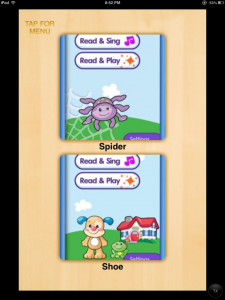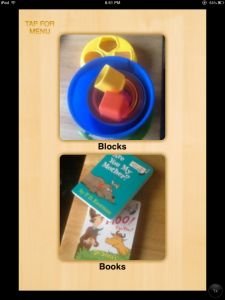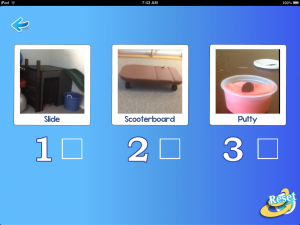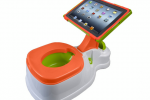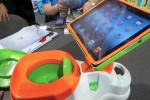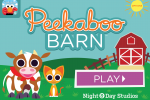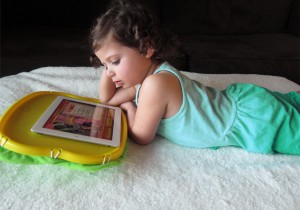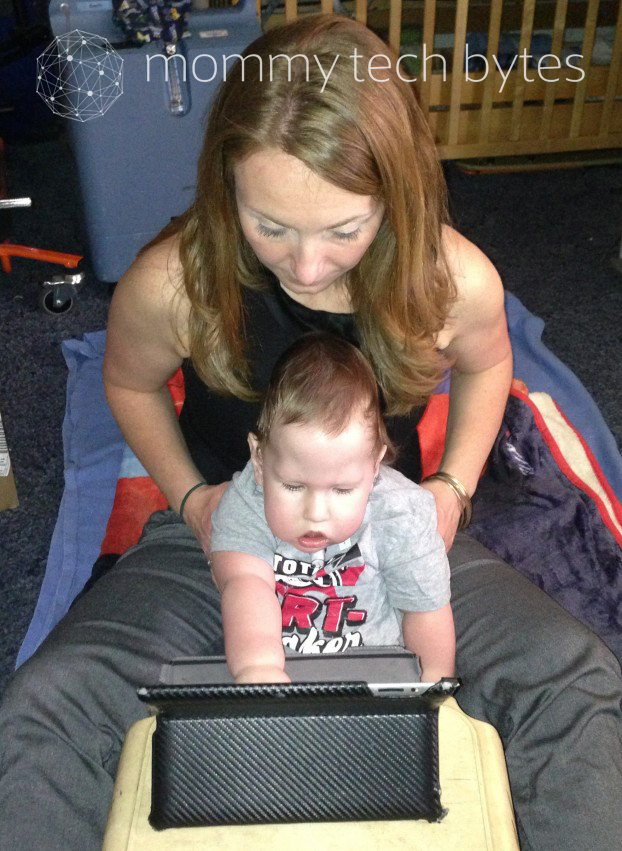
Interview with Pediatric OT Amy B. VanCamp
Aiden Singleton has Muscular Dystrophy. He is 18 months old. And app therapy is changing his life, thanks to the iPad and the work of dedicated pediatric occupational therapist Amy B. VanCamp.
Mommy Tech Bytes caught up with VanCamp to learn more about how she is helping children with special needs, like Aiden, through meaningful app therapy.
Once a week for the past year, VanCamp (who works for Carolina Occupational Therapy, Asheville, NC) has met with Aiden at his home. Recently, a breakthrough moment came. VanCamp explains:
VC: We had been utilizing the iPad and a variety of apps for several months to increase purposeful movement, cause and effect, visual motor and visual attention skills. During our treatment session, Aiden was able to make a choice between two stories utilizing the SoundingBoard app to listen to his preferred story Where’s Puppy’s Nose? (from the Fisher Price Laugh and Learn series). He was also able to activate each page to turn with his hand after the narrator completed a reading.
Can you explain the significance of this breakthrough for Aiden?
This simple act of listening and touching the iPad to listen to a story seems so simple, but this small action requires appropriate pressure and release, attention, visual motor skills and eye hand coordination skills.” (VanCamp)
When did you begin integrating digital platforms into your therapy practice and how did it come about?
VC: OTs have been using a variety of digital platforms for years. We used computers with adaptive keyboards, switches and a variety of learning software programs. As technology has evolved, especially with the introduction of the iPad, we have begun utilizing it more heavily into our practice to help children maximize their level of participation, interaction and function within their activities of daily living (also known as ADLs).
What types of disabilities do you typically work with?
VC: I work with a variety of disabilities, including, but not limited to children with autism, cerebral palsy, developmental delays, sensory processing dysfunction, ADHD, muscular dystrophy, a variety of genetic disorders, and down syndrome.
How do you evaluate incorporating technology into the therapy process?
VC: Every child requires a comprehensive evaluation before beginning treatment in which the child/family and occupational therapist determine the child’s goals. A customized intervention is then fabricated to meet the needs specifically to that child. OT services may include, but are not limited to the use of technology as a modality depending on a child’s cognitive, neuromuscular, and sensorimotor skills. Occupational therapists use a holistic approach – adapting the environment to fit the person when working with individuals. With the advancement of technology and widespread use of apps, the ability to modify the environment for children has become increasingly easier due to the availability of tablets, affordability, and ease of use.
What makes the iPad your favorite tablet of choice in your therapy?
VC: The accessibility features (VoiceOver, Zoom, Large Text, Speak Selection and Text to Speech) that come standard on all Apple products meet many needs for our clients. Children with visual, hearing and motor impairments can all benefit from these features. Previously different software [i.e. for computers] was needed to meet the needs of these individuals.
Is the therapy treatment process different depending on the type of disability a patient might have?
Yes, for sure! As with any type of treatment, a therapist will look not only at the child’s disability, but also the child’s age, cognitive ability, neuromuscular status, upper extremity function, and/or sensory processing skills to determine the child’s treatment plan. A child with a specific impairment such as a visual impairment may benefit from some of the basic accessibility features of the iPad and then supplement with apps. Apps like Little Finder, Eye Movement Training, and Doodle Find can help with visual scanning, visual attention, visual memory, visual figure ground and other visual perceptual skills. However, a child with limited motor skills would benefit from different accessibility features and/or apps.
Do you customize apps for your clients?
VC: Yes. The SoundingBoard app and ASD Tools app can both be used to create custom boards. (Custom boards can be created using graphics from the apps’ own image libraries or your own photos).
Here are two examples of customized boards created by Van Camp:
How do you use apps to improve writing skills in children with disabilities?
VC: I use many apps to help facilitate pre-writing strokes, shapes, letters and numbers. The majority of kids are more interested in utilizing the iPad because of it being fun and interactive than the “old fashion” way of writing. This has proven especially true with children with autism. Often times therapists “give up” on the idea of writing with children with autism because of a child’s lack of motivation or interest. Simple writing apps like Pre-K Letters and Numbers, Little Writer, and Doodle Buddy, to name a few) have given therapists another way of teaching writing in a multi-sensory / technology approach.
What kind of results have you seen overall through your app therapy with children?
VC: Increased motivation, participation, communication, fine motor and visual motor skills.
How would you suggest other OTs incorporate apps into their treatment practices for special needs?
VC:
- Spend time researching which apps would be most appropriate for the types of children you are specifically treating.
- Categorize your apps into folders on your iPad that will make it quick and easy for you to use during therapy.
- OTs with Apps by Carole Leynse Harpold is a great website for therapists and features an OT iTool Kit broken out by category, disability, device, and price.
- Most importantly, just start playing around…there are many FREE apps out there. Some of them offer lite versions initially, and once you know you like them you can purchase the full program.
What kind of outcomes do you hope to achieve by using apps with special needs patients now and in the future?
VC:
- Increase motivation and ability to attend to educational activities through fun and ease of use.
- Increase communication skills.
- Facilitate pre-writing, letter writing, and drawing skills.
- Increase visual perceptual skills.
- Increase Activities of Daily Living skills through use of apps like Shoe Tying 1.
- Increase math skills.
- Break down barriers and help level the playing field between children with disabilities and their peers.
Based on the results you’ve already seen, do you think improvements in technology will allow you to accomplish even more in the future?
VC: Yes for sure! Technology just keeps getting better and better for children with disabilities. With improvement of technology it truly helps break down barriers and helps to level the playing field between children with disabilities and their peers from pre-school all the way through college. (See 5 Ways the iPad Helps Children with Disabilities.)
What has been most challenging part for you in using apps / technology with your disabilities clients?
VC: The biggest challenge is that not all families can afford an iPad or other technology and insurance companies have not yet gotten on board with funding this type of technology despite significant gains that could be made. Most insurance companies will not fund an iPad; however they will fund other types of devices such as DynaVox and/or other higher end augmentation communication devices.
In addressing the “rewarding” side of your job, how do you feel after seeing the progression a patient makes through the app therapy process?
VC: Seeing the smiles not only on the “little” people, but also on the “big” people. There is nothing more than a mother and father want than for their children to have the skills to grow and be the best that they can be. A child who is now able to “write” their name, tell their family their wants and needs, and say “I love you” through the use of technology is priceless.
ABOUT AMY B. VANCAMP, PEDIATRIC OT
Amy B. VanCamp has worked as a pediatric occupational therapist for 13 years with specialized experience in early intervention, school based therapy and hospital settings. During the last eight years she has gained expertise and led trainings on utilizing technology in special education therapy. She currently works at Carolina Pediatric Therapy and lives with her husband and two children in the surrounding area of Asheville, NC. If you’d like to contact her, please email her at avancamp@carolinapeds.com. Phone: 828-670-8056.
Please SHARE this post and spread the word about the benefits of app therapy for children with special needs.

